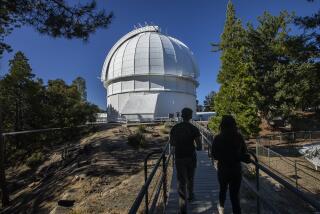San Diego County Clipboard : Palomar Observatory
- Share via
Conceived by the American astronomer George Ellery Hale and financed by the Rockefeller Foundation, construction of the Palomar Observatory was completed in 1948. 40 miles northeast of the city of San Diego, at an altitude of 5,660 feet above sea level, Palomar’s reflecting telescope (with its 200-inch primary mirror) was the world’s largest until 1974 when the Soviet Union constructed the 236-inch UTR-Z at Zelenchyukskaya, U.S.S.R.
The Mount Palomar and Mount Wilson Observatories-known as the Hale Observatories-conducted astronomical research for the California Institute of Technology and the Carnegie Institution of Washington, D.C.
Collecting a million times as much light as the human eye, the Hale telescope takes long-exposure photographs of faint celestial objects. Its photoelectric photometer accurately measures the brightness of stars to calculate their distance from Earth. A spectrograph is also used to determine a star’s chemical composition.
The observatory also has two 48-inch wide-angle Schmidt reflector telescopes for photographing an area of the sky 300 times larger than the Hale is capable of, and a 60-inch general-purpose reflecting telescope.
A. Dome: Highly reflective silver paint deflects sun’s rays, keeping dome interior cool.
B. Dome Shutter: A 30-foot wide slot in the dome gives the telescope a view of the heavens while the rest of the dome shields it from wind currents.
C. Prime-Focus Cage: Atop the telescope, an astronomer can sit inside the tube and focus the secondary hyperboloid mirror.
D. Equatorial Mount: Holds the telescope so it can move up or down (Declination). The horseshoe-shaped top of the mounting enables the telescope to point directly overhead.
E. Declination Gear: With this gear, astronomers can swivel the telescope left or right (Right Ascension).
F. Primary Mirror: Also known as the parabolic primary, this mirror is first to receive light from faraway stars.
G. Right Ascension Drive: This motor turns the telescope right or left (Right Ascension).
H. Dial-a-Star: From this station, an astronomer selects a celestial object from the computer control, determines its coordinates (Declination and Right Ascension), activating motors that slowly spin the telescope into position.
Polar alignment for Telescope: The polar axis of the telescope’s equatorial mount is aimed at the North Celestial Pole. This, in conjunction with the observatory’s clockwise rotation compensates for the Earth’s rotation, keeping celestial objects stationary in the the telescope’s field of view.
The Hale Telescope: A Cassegrain Reflector
1. Light from a celestial object enters telescope.
2. The concave primary mirror narrows the reflected image, sending it to the secondary mirror.
3. Secondary mirror continues to narrow the reflected image.
4. At the Cassegrain Focus, the image is viewed or directed elsewhere in observatory.
Source: Incredible Cross-Sections, by Stephen Biesty; The Audubon Society Field Guide to The Night Sky






